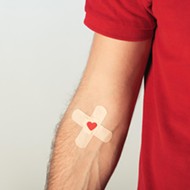Mailpocalypse: In the digital age, politicians still rely on snail mail to get your vote
By Chris McGuinness[{
"name": "Ad - Medium Rectangle CC01 - 300x250",
"id": "AdMediumRectangleCC01300x250",
"class": "inlineCenter",
"insertPoint": "8",
"component": "2963441",
"requiredCountToDisplay": "12"
},{
"name": "Ad - Medium Rectangle LC01 - 300x250",
"id": "AdMediumRectangleCC01300x250",
"class": "inlineCenter",
"insertPoint": "18",
"component": "2963441",
"requiredCountToDisplay": "22"
},{
"name": "Ad - Medium Rectangle LC09 - 300x250",
"id": "AdMediumRectangleLC09300x250",
"class": "inlineCenter",
"insertPoint": "28",
"component": "3252660",
"requiredCountToDisplay": "32"
}]

As the final days of the election count down, SLO County residents are likely sifting through mountains of political mailers for candidates, ballot propositions, and causes before getting to their letters, bills, and Amazon packages.
In a country that increasingly lives with one foot firmly planted in the digital world, targeted mailing is still a must for politicians running at the local, state, and even national levels. In some cases, spending on such mailers can rival or even outpace spending on political web, radio, and television advertising.
"It's because people still look at what's in their mailbox," said Julie Hanford, owner of SLOCO Data and Printing in Grover Beach. "Even if they throw it away on their way back to their house, they still look at it."
Hanford said her company has been offering services for political mailers in San Luis Obispo County for 30 years. The company first began as a real estate marketing database service. But about two years after the company was founded, Hanford said she decided to branch out.
"We realized we had these mailing lists, so we started doing direct mailing," she said, noting that political direct mail makes up about one quarter of her total business.
Hanford's business pops up in expenditure reports for several local political campaigns. SLO County 3rd District Supervisor candidate Dan Carpenter spent more than $25,000 on the company's services between January and late September 2016. Campaign expenditures for 1st District Supervisor candidate John Peschong showed his campaign spending more than $5,700 on SLOCO Data's services for the same time period.
Peschong, a long-time political consultant, appears to have invested heavily in mailers and other campaign literature from multiple companies. His campaign spent a total of $72,141 on campaign literature between early January and late September alone. Those expenditures made up about 39 percent of Peschong's total payments made for that same reporting period.
One direct mailing company getting a sizable portion of that money is Landslide Communications. The Irvine-based company specializes in creating "slate mailers," which list and suggest candidates and ballot measures based on specific issues. According to the company's website, the mailers are targeted to "middle-of-the-road and conservative voters" it claims make up 65 percent of California's electorate. In the June primary election alone, the company sent out more than 6.4 million pieces of mail.
In a written statement to New Times, Landslide's owner James Lacey called direct-mail messaging "one of the most important tools" in political persuasion, noting that people can delete emails or place them in a junk folder without actually looking at them.
"Direct mail, however, can be targeted to swing voters. It cannot be deleted," Lacey said. "Though it may go into a 'junk pile,' it does not automatically go into a 'junk file,' and the recipient has to physically hold and look at a direct-mail communication to even throw it out. Something gets communicated even if the recipient is not open to it, because it is 'in their home.'"
Many candidates appear to share Lacey's faith in the power of direct mail. That includes Jordan Cunningham, the Republican candidate for the 35th state Assembly District. In addition to spending heavily on television and radio advertising, Cunningham spent more than $113,402 on mailers and campaign literature services from Landslide Communications and others between January and late September of this year. His opponent, Dawn Ortiz-Legg, spent $27,765 for the same period on mailers and literature aimed at persuading voters.
And that's just money coming from the campaigns. Political Action Committees, or PACs, can raise and spend millions on political advertising independent of the campaigns themselves.
While mailers are still a good bet for politicians, it doesn't mean that candidates are ignoring the web as a means to persuade voters. Most people running for office have a web presence, using both graphic and video advertising, as well as social media networks like Facebook and Twitter. Detailed internet analytics allow candidates to get their message to specific groups of voters, said Brian O'Grady, a principal with Clarify, a digital consulting and advertising agency based in Oakland.
"You can really zero in on a given age group, gender, geographic location or region, household income ... all types of consumers," said O'Grady, whose firm has worked with Salud Carbajal, the Democrat running for California's 24th Congressional District, to the tune of $13,656.
While digital messages may be cheaper and more nimble, don't expect that mailbox to be any less cluttered during the next big election.
"About a decade ago, some observers were predicting that 'emails' would revolutionize political communications. But they have not, because they can go easily into spam files and be deleted before they are read," Lacey said.
Staff Writer Chris McGuinness can be reached at [email protected], or on Twitter at @CWMcGuinness.
Latest in News
Readers also liked…
-

Coast Unified teachers upset over new position's salary and qualifications
Oct 20, 2022 -

SLO police identify alleged driver who hit and killed couple
Dec 22, 2022 -

When the levee breaks: Oceano residents, county officials walk a tightrope of regulations to manage Arroyo Grande Creek, which some say led to the levee's failure in January
May 18, 2023








